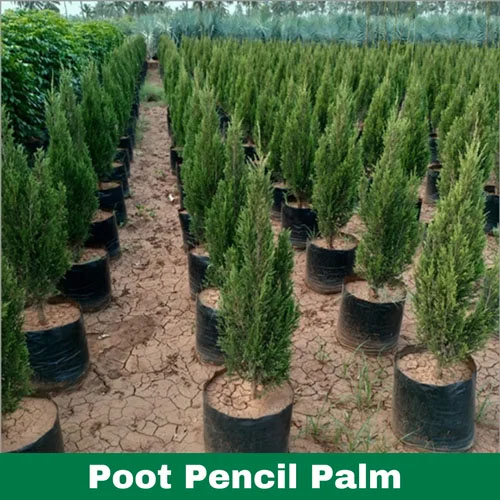Pencil Plam Plants
Pencil Palm typically refers to Dracaena deremensis 'Janet Craig' or Dracaena surculosa. This plant is often known for its slender, upright appearance, which resembles pencils, hence the name. It's a popular choice for indoor spaces due to its striking appearance and ease of care.
Features of Pencil Palm Plants:
-
Foliage:
- Color: The leaves are typically green, though some varieties may have variegated or multi-colored foliage.
- Shape: The leaves are long, narrow, and arranged in a rosette pattern, giving the plant a pencil-like appearance.
-
Growth Habit:
- Form: The plant has an upright, columnar growth habit. It can grow to about 3-6 feet tall, depending on the variety and growing conditions.
- Height: Pencil Palms generally reach around 3-6 feet in height, with a compact width.
-
Care Tips for Pencil Palm Plants:
-
Sunlight:
- Light: They prefer bright, indirect light but can tolerate lower light conditions. Avoid direct sunlight, which can scorch the leaves.
-
Soil:
- Type: Use well-draining soil, such as a peat-based potting mix. Good drainage is essential to prevent root rot.
- pH: They prefer slightly acidic to neutral soil pH (6.0 to 7.0).
-
Watering:
- Frequency: Water when the top inch of soil feels dry. Overwatering can lead to root rot, so ensure the pot has good drainage.
- Method: Water thoroughly, allowing excess water to drain out of the bottom of the pot.
-
Fertilizing:
- Type: Use a balanced, water-soluble fertilizer. Feed monthly during the growing season (spring and summer).
- Timing: Reduce feeding during the fall and winter when the plant’s growth slows.
-
Pruning:
- Purpose: Prune to remove any dead or damaged leaves and to maintain the plant’s shape.
- Timing: Prune as needed throughout the year. Remove any yellow or brown leaves to keep the plant looking its best.
-
Pest and Disease Control:
- Pests: Pencil Palms can occasionally be affected by pests such as spider mites, scale insects, and mealybugs. Treat with insecticidal soap or neem oil if necessary.
- Diseases: Watch for signs of fungal diseases like root rot, especially if overwatering. Ensure good air circulation around the plant and avoid waterlogging.
-
Uses and Benefits:
- Ornamental: Pencil Palms are popular as indoor plants due to their elegant, upright form and ability to adapt to various light conditions.
- Low Maintenance: They are relatively easy to care for, making them a good choice for both novice and experienced plant enthusiasts.
- Air Purification: Like many Dracaena species, they can help improve indoor air quality by removing toxins.
If you have specific questions about Pencil Palms or need further details on their care, feel free to ask!


